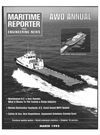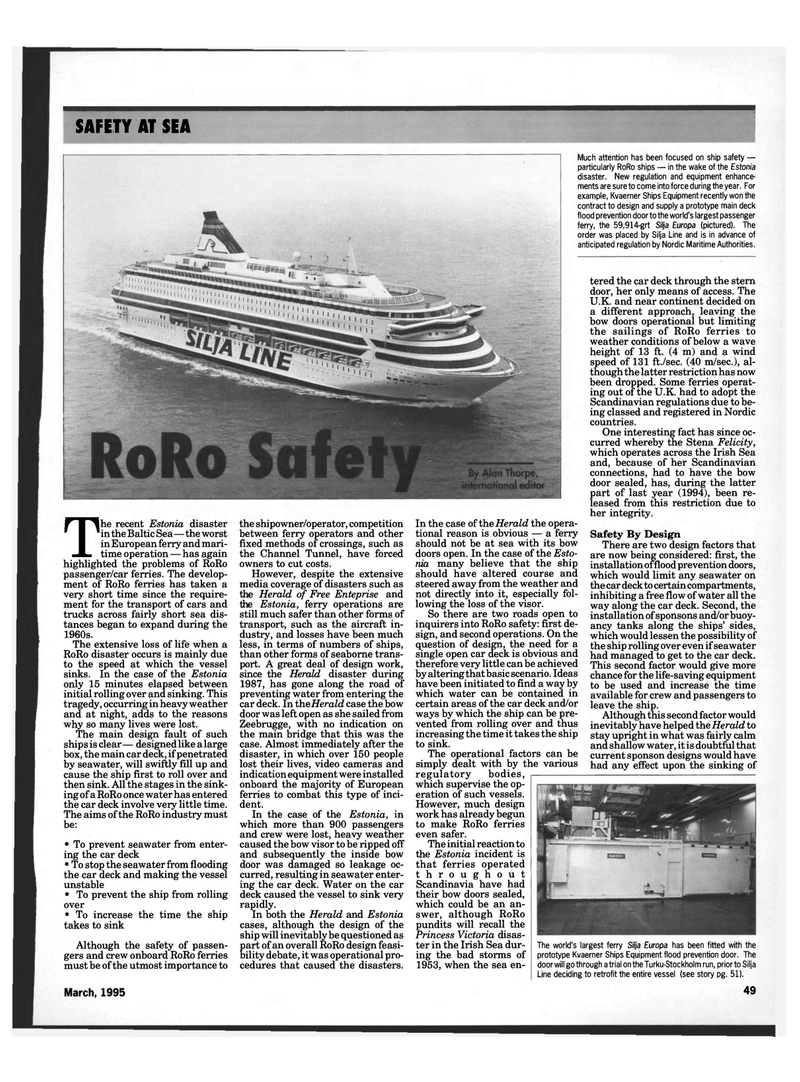
Page 47: of Maritime Reporter Magazine (March 1995)
Read this page in Pdf, Flash or Html5 edition of March 1995 Maritime Reporter Magazine
SAFETY AT SEA
Much attention has been focused on ship safety — particularly RoRo ships — in the wake of the Estonia disaster. New regulation and equipment enhance- ments are sure to come into force during the year. For example, Kvaerner Ships Equipment recently won the contract to design and supply a prototype main deck flood prevention door to the world's largest passenger ferry, the 59,914-grt Silja Europa (pictured). The order was placed by Silja Line and is in advance of anticipated regulation by Nordic Maritime Authorities.
The recent Estonia disaster in the Baltic Sea—the worst in European ferry and mari-time operation — has again highlighted the problems of RoRo passenger/car ferries. The develop- ment of RoRo ferries has taken a very short time since the require- ment for the transport of cars and trucks across fairly short sea dis- tances began to expand during the 1960s.
The extensive loss of life when a
RoRo disaster occurs is mainly due to the speed at which the vessel sinks. In the case of the Estonia only 15 minutes elapsed between initial rolling over and sinking. This tragedy, occurring in heavy weather and at night, adds to the reasons why so many lives were lost.
The main design fault of such ships is clear — designed like a large box, the main car deck, if penetrated by seawater, will swiftly fill up and cause the ship first to roll over and then sink. All the stages in the sink- ing of a RoRo once water has entered the car deck involve very little time.
The aims of the RoRo industry must be: • To prevent seawater from enter- ing the car deck • To stop the seawater from flooding the car deck and making the vessel unstable • To prevent the ship from rolling over • To increase the time the ship takes to sink
Although the safety of passen- gers and crew onboard RoRo ferries must be of the utmost importance to the shipowner/operator, competition between ferry operators and other fixed methods of crossings, such as the Channel Tunnel, have forced owners to cut costs.
However, despite the extensive media coverage of disasters such as the Herald of Free Enteprise and the Estonia, ferry operations are still much safer than other forms of transport, such as the aircraft in- dustry, and losses have been much less, in terms of numbers of ships, than other forms of seaborne trans- port. A great deal of design work, since the Herald disaster during 1987, has gone along the road of preventing water from entering the car deck. In theHerald case the bow door was left open as she sailed from
Zeebrugge, with no indication on the main bridge that this was the case. Almost immediately after the disaster, in which over 150 people lost their lives, video cameras and indication equipment were installed onboard the majority of European ferries to combat this type of inci- dent.
In the case of the Estonia, in which more than 900 passengers and crew were lost, heavy weather caused the bow visor to be ripped off and subsequently the inside bow door was damaged so leakage oc- curred, resulting in seawater enter- ing the car deck. Water on the car deck caused the vessel to sink very rapidly.
In both the Herald and Estonia cases, although the design of the ship will inevitably be questioned as part of an overall RoRo design feasi- bility debate, it was operational pro- cedures that caused the disasters.
In the case of the Herald the opera- tional reason is obvious — a ferry should not be at sea with its bow doors open. In the case of the Esto- nia many believe that the ship should have altered course and steered away from the weather and not directly into it, especially fol- lowing the loss of the visor.
So there are two roads open to inquirers into RoRo safety: first de- sign, and second operations. On the question of design, the need for a single open car deck is obvious and therefore very little can be achieved by altering that basic scenario. Ideas have been initiated to find a way by which water can be contained in certain areas of the car deck and/or ways by which the ship can be pre- vented from rolling over and thus increasing the time it takes the ship to sink.
The operational factors can be simply dealt with by the various regulatory bodies, which supervise the op- eration of such vessels.
However, much design work has already begun to make RoRo ferries even safer.
The initial reaction to the Estonia incident is that ferries operated throughout
Scandinavia have had their bow doors sealed, which could be an an- swer, although RoRo pundits will recall the
Princess Victoria disas- ter in the Irish Sea dur- ing the bad storms of 1953, when the sea en- tered the car deck through the stern door, her only means of access. The
U.K. and near continent decided on a different approach, leaving the bow doors operational but limiting the sailings of RoRo ferries to weather conditions of below a wave height of 13 ft. (4 m) and a wind speed of 131 ft./sec. (40 m/sec.), al- though the latter restriction has now been dropped. Some ferries operat- ing out of the U.K. had to adopt the
Scandinavian regulations due to be- ing classed and registered in Nordic countries.
One interesting fact has since oc- curred whereby the Stena Felicity, which operates across the Irish Sea and, because of her Scandinavian connections, had to have the bow door sealed, has, during the latter part of last year (1994), been re- leased from this restriction due to her integrity.
Safety By Design
There are two design factors that are now being considered: first, the installation of flood prevention doors, which would limit any seawater on the car deck to certain compartments, inhibiting a free flow of water all the way along the car deck. Second, the installation of sponsons and/or buoy- ancy tanks along the ships' sides, which would lessen the possibility of the ship rolling over even if seawater had managed to get to the car deck.
This second factor would give more chance for the life-saving equipment to be used and increase the time available for crew and passengers to leave the ship.
Although this second factor would inevitably have helped the Herald to stay upright in what was fairly calm and shallow water, it is doubtful that current sponson designs would have had any effect upon the sinking of
The world's largest ferry Silja Europa has been fitted with the prototype Kvaerner Ships Equipment flood prevention door. The door will go through a trial on the Turku-Stockholm run, prior to Silja
Line deciding to retrofit the entire vessel (see story pg. 51).
March, 1995 49

 46
46

 48
48
